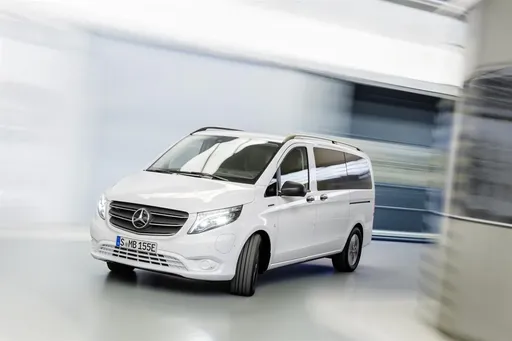Mercedes Vito Bus vs Renault Trafic Bus - Differences and prices compared
Compare performance (237 HP vs 170 HP), boot space and price (36300 £ vs 38200 £) at a glance. Find out which car is the better choice for you – Mercedes Vito Bus or Renault Trafic Bus?
Costs and Efficiency:
Price and efficiency are often the first things buyers look at. Here it becomes clear which model has the long-term edge – whether at the pump, the plug, or in purchase price.
Mercedes Vito Bus has a hardly perceptible advantage in terms of price – it starts at 36300 £, while the Renault Trafic Bus costs 38200 £. That’s a price difference of around 1909 £.
Both cars consume an average of 6.70 L per 100 km – no difference here.
Engine and Performance:
Power, torque and acceleration are the classic benchmarks for car enthusiasts – and here, some clear differences start to show.
When it comes to engine power, the Mercedes Vito Bus has a noticeable edge – offering 237 HP compared to 170 HP. That’s roughly 67 HP more horsepower.
In terms of top speed, the Renault Trafic Bus performs evident better – reaching 180 km/h, while the Mercedes Vito Bus tops out at 140 km/h. The difference is around 40 km/h.
There’s also a difference in torque: Mercedes Vito Bus pulls noticeable stronger with 500 Nm compared to 380 Nm. That’s about 120 Nm difference.
Space and Everyday Use:
Whether family car or daily driver – which one offers more room, flexibility and comfort?
Seats: Renault Trafic Bus offers somewhat more seating capacity – 9 vs 8.
In curb weight, Mercedes Vito Bus is barely noticeable lighter – 2023 kg compared to 2031 kg. The difference is around 8 kg.
In maximum load capacity, the Mercedes Vito Bus performs to a small extent better – up to 4990 L, which is about 990 L more than the Renault Trafic Bus.
When it comes to payload, Mercedes Vito Bus barely noticeable takes the win – 1077 kg compared to 982 kg. That’s a difference of about 95 kg.
Who comes out on top?
Overall, the Mercedes Vito Bus shows itself to be dominates this comparison and secures the title of DriveDuel Champion.
It convinces with the more balanced overall package and proves to be the more versatile choice for everyday use.

Mercedes Vito Bus
Costs and Consumption
View detailed analysis
Engine and Performance
View detailed analysis
Dimensions and Body
View detailed analysis
Mercedes Vito Bus
The Mercedes Vito is a sturdy, no-nonsense people carrier that blends commercial practicality with a surprisingly civilised cabin, making long shuttles feel less like a chore. If you need a dependable transporter that swallows luggage, forgives hard use and still looks a touch more premium than a plain van, the Vito is an easy, sensible pick.
details
Renault Trafic Bus
The Renault Trafic is a practical people-carrier that prefers sensible space and smart flexibility to showroom gloss, making it a top pick for families, shuttle operators or anyone ferrying a crowd without fuss. It’s comfortable, economical in everyday running and blessedly uncomplicated — not the most glamorous vehicle, but brilliantly dependable when you need it to be.
details

|
|
|
|
|
Costs and Consumption |
|
|---|---|
|
Price
36300 - 55900 £
|
Price
38200 - 54400 £
|
|
Consumption L/100km
6.7 - 10 L
|
Consumption L/100km
6.7 - 7.2 L
|
|
Consumption kWh/100km
26.7 - 26.9 kWh
|
Consumption kWh/100km
-
|
|
Electric Range
248 - 370 km
|
Electric Range
-
|
|
Battery Capacity
60 - 90 kWh
|
Battery Capacity
-
|
|
co2
0 - 228 g/km
|
co2
175 - 189 g/km
|
|
Fuel tank capacity
57 - 70 L
|
Fuel tank capacity
80 L
|
Dimensions and Body |
|
|---|---|
|
Body Type
Bus
|
Body Type
Bus
|
|
Seats
8
|
Seats
8 - 9
|
|
Doors
4
|
Doors
4
|
|
Curb weight
2023 - 2739 kg
|
Curb weight
2031 - 2352 kg
|
|
Trunk capacity
580 - 1390 L
|
Trunk capacity
-
|
|
Length
4895 - 5370 mm
|
Length
5080 - 5480 mm
|
|
Width
1928 mm
|
Width
1956 mm
|
|
Height
1890 mm
|
Height
1973 - 1974 mm
|
|
Max trunk capacity
4190 - 4990 L
|
Max trunk capacity
3200 - 4000 L
|
|
Payload
726 - 1077 kg
|
Payload
718 - 982 kg
|
Engine and Performance |
|
|---|---|
|
Engine Type
Diesel, Electric, Petrol
|
Engine Type
Diesel
|
|
Transmission
Automatic
|
Transmission
Manuel, Automatic
|
|
Transmission Detail
Automatic Gearbox, Reduction Gearbox
|
Transmission Detail
Manual Gearbox, Automatic Gearbox
|
|
Drive Type
Rear-Wheel Drive, All-Wheel Drive, Front-Wheel Drive
|
Drive Type
Front-Wheel Drive
|
|
Power HP
136 - 237 HP
|
Power HP
110 - 170 HP
|
|
Acceleration 0-100km/h
-
|
Acceleration 0-100km/h
10.6 - 16.5 s
|
|
Max Speed
140 km/h
|
Max Speed
161 - 180 km/h
|
|
Torque
330 - 500 Nm
|
Torque
300 - 380 Nm
|
|
Number of Cylinders
4
|
Number of Cylinders
4
|
|
Power kW
100 - 174 kW
|
Power kW
81 - 125 kW
|
|
Engine capacity
1950 - 1999 cm3
|
Engine capacity
1997 cm3
|
General |
|
|---|---|
|
Model Year
2024
|
Model Year
2023 - 2025
|
|
CO2 Efficiency Class
G, A
|
CO2 Efficiency Class
G, F
|
|
Brand
Mercedes-Benz
|
Brand
Renault
|
What drive types are available for the Mercedes Vito Bus?
The Mercedes Vito Bus is offered with Rear-Wheel Drive, All-Wheel Drive or Front-Wheel Drive.
The prices and data displayed are estimates based on German list prices and may vary by country. This information is not legally binding.
